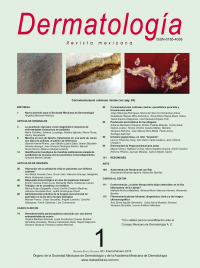Dermatol Rev Mex. 2019 enero-febrero;63(1):40-59.
Evelyn Vanesa Erazo-Luna,1 Margarita María Velásquez-Lopera2
1 Médica y cirujana, residente de Dermatología.
2 Dermatóloga, Doctora en Ciencias Biomédicas con énfasis en Inmunología. Centro de Investigaciones Dermatológicas CIDERM.
Sección de Dermatología, Facultad de Medicina, Universidad de Antioquia, Medellín, Colombia.
Resumen
El sistema inmunológico debe reconocer, controlar y eliminar una gran cantidad de agentes, internos, externos o ambos, potencialmente nocivos. Uno de ellos es el virus del papiloma humano (VPH), que en la mayor parte de los casos se elimina gracias al concurso de la inmunidad innata y la inmunidad adaptativa. En algunas condiciones no totalmente conocidas, el VPH evade el sistema inmunológico, llevando a infecciones persistentes y a la aparición de neoplasias malignas. La persistencia viral es favorecida por condiciones, como la infección del epitelio estratificado de la piel y las mucosas, donde las células del sistema inmunológico están limitadas en número y diversidad con respecto a otras áreas anatómicas y por la integración del genoma viral en la célula del hospedero, lo que induce cambios en su biología y la transformación maligna. En este artículo se revisan las principales interacciones que ocurren entre el VPH y el sistema inmunológico.
PALABRAS CLAVE: Papillomaviridae; virus del papiloma humano; proteínas virales; sistema inmunitario; inmunidad innata; inmunidad adaptativa; vacunas contra el virus del papiloma.
Abstract
The immune system must recognize, control and eliminate many internal and external agents that are potentially harmful to the organism. One of these agents is the human papillomavirus (HPV), whose infection is usually contained through the cooperation of innate and adaptive immunity of the host. However, it is important to recognize how, under certain not fully clarified conditions, HPV evades the immune system using a wide array of mechanisms from the earliest moments of infection to the latest phases. Early mechanisms such as choice of target infection of the stratified epithelium and mucous membranes, where immunological cells are scarce, clearly help avoid generating an elaborate immune response. Late mechanisms where HPV manages to integrate its genome in to the host cell, completely changing its biology, ultimately provoke malignant transformation. In this article, the interactions that occur between HPV and the immune system are reviewed.
KEYWORDS: Papillomaviridae; Human papillomavirus; Viral proteins; Immune system; Immunity, innate; Adaptive immunity; Papillomavirus vaccines.

